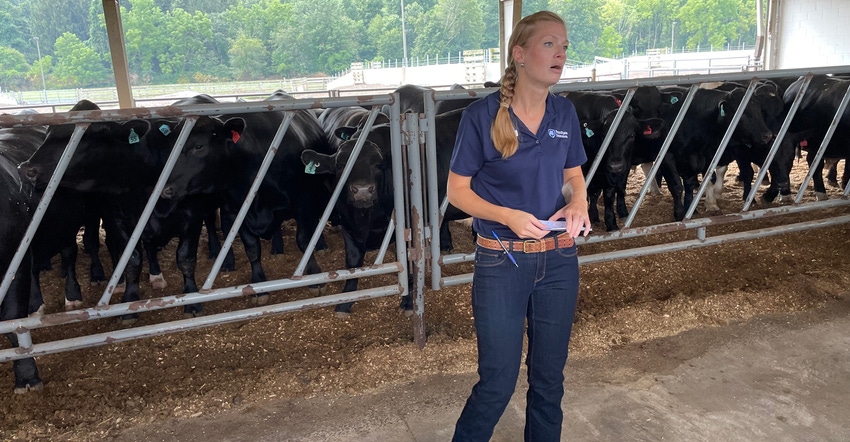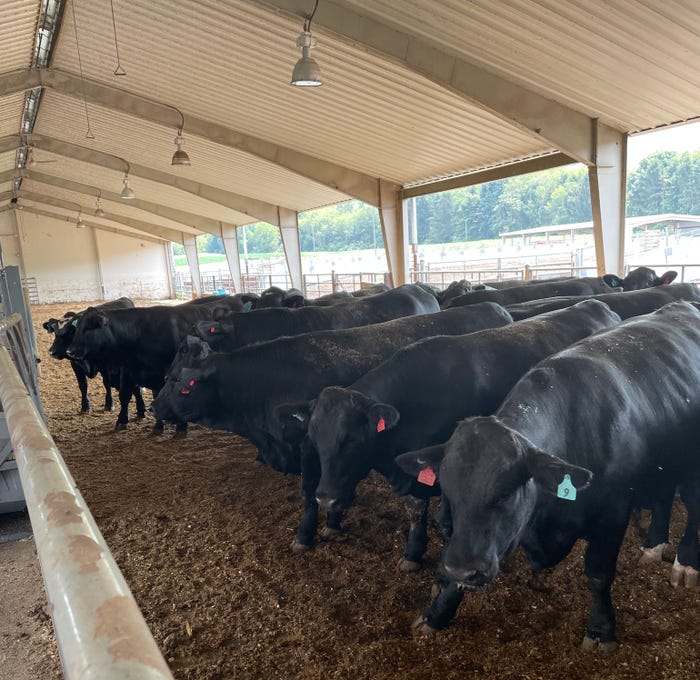
Using beef semen in dairy cattle is nothing new. Dairy farmers have been doing this for a long time. But with 2.5 million crossbred calves now entering the beef supply chain — out of a total 26 million fat cattle killed per year — it raises a lot of questions about the value of these animals and the opportunities producers have to cash in.
"That's 10% of our industry wrapped up in these crossbred beef-on-dairy calves that we're still somewhat uncertain about, and that's a question we have to answer," says Tara Felix, Extension beef specialist with Penn State.
For the past five years, Penn State, along with the Pennsylvania beef working group — comprised of Pennsylvania Cattlemen’s Association, Center for Beef Excellence, Cooperative Extension, select beef producers and others — has been researching ways to increase the economic value of the Holstein steer as it’s fed for beef production to benefit both beef and dairy producers.
They’ve shifted gears and started focusing on the use of implants to increase rate of gain and feed efficiency, and to focus on beef processing and forage for these steers.
Last year, they shifted gears again and started looking at matching appropriate beef sire breeds with dairy cows. It’s a three-year project, funded through USDA, that Felix says doesn’t have any answers yet, but considering the big increase in beef semen straws the past couple of years, the project has a lot of relevance.
Semen sales way up
In 2018, published beef breeding statistics showed a 56% increase in the sale of beef semen straws from 2017 to 2018, and a 250% increase in beef semen straws through today, Felix says. Historically, the sale of beef semen has held steady but hasn’t shown big increases year over year.
That’s because most beef breeding, especially in the Midwest and West, is done through natural service. The exception is in dairy where AI is widely used.
“Most of the increase in beef semen has been attributed to the dairy industry,” Felix says. “As a result of those breeding decisions on dairy dams, we’ve seen a number of crossbred beef dairy, beef sire on dairy dam, come in on beef production supply chains.”
Angus king, other breeds growing
In terms of beef sires, Angus is the most popular breed and has the most popular sires. But the trial also includes Simmental and SimAngus sires, a significant point given that Holstein Association USA and the American Simmental Association have partnered to develop the HolSim branded beef program.
Other “off breed” beef breeds are also gaining in popularity. For example, Charolais beef semen sales have increased 270% the past couple of years, Felix says.
The focus of the research, she says, is to find traits in the dairy animal that can be improved by breeding a beef sire to it, creating more value for a dairy producer.

LOTS OF QUESTIONS: Crossbred beef-dairy calves are entering the beef supply chain. But what are desirable traits that should be bred to dairy cattle, and will these calves be attractive to the packers that market them?
“First and foremost, we know that dairy cows are what we call a flat muscle breed,” Felix says. “So when we look at their rib-eye steaks, they look like a strip-loin steak, long and narrow, whereas when we look at a steak from an Angus animal, it's a nice, round steak, and that's what we want from a beef animal. That's what the consumer desires from a beef animal.”
Increasing the amount of meat from a single animal is also important, she says. While a native beef steer expects to dress out at 62% of live weight, about 45% of that will be saleable red meat. Holstein steers dress out at even lower percentages, and their saleable red meat is also lower.
“What we’re trying to do is by using a beef breed, can we get more saleable red meat out of that Holstein’s progeny?” Felix says. “And then, which breeds should we use and then within that breed, the ideal sire, because we know there are certain sires that bring different traits.”
Keeping packers happy
You also must consider the packer, Felix says, and whether these crossbred beef-dairy progenies will yield something a packer finds desirable.
“The beef production system in the U.S., for better or worse, functions on a commodity-style system, boxed beef. And it has to fit in that box for it to be shipped. So there are certain ranges and sizes of muscle desired for that boxed-beef system,” she says. “They have a boxed-beef system for native cattle and Holstein cattle, and now we have to figure out where these crossbreeds fit in because that will determine their value in the value chain.
“That commodity boxed-beef system deals in uniformity,” Felix adds. “We are taking that Holstein steer, which has about 3% genetic variation, and introducing a lot of different sires and a lot of different breeds and introducing quite a bit of variation, and that's something that we are still working on.”
Right now, the economics of the system, she says, favors the dairy producer because even though calves sell for quite a bit more than Holstein steers, the production costs and sale price points are similar.
“So the question remains, are they so much more efficient that the efficiency decreases days on feed and pays or does the upcharge you see on the calf pay? These questions still have to be answered,” Felix says.
About the Author(s)
You May Also Like






